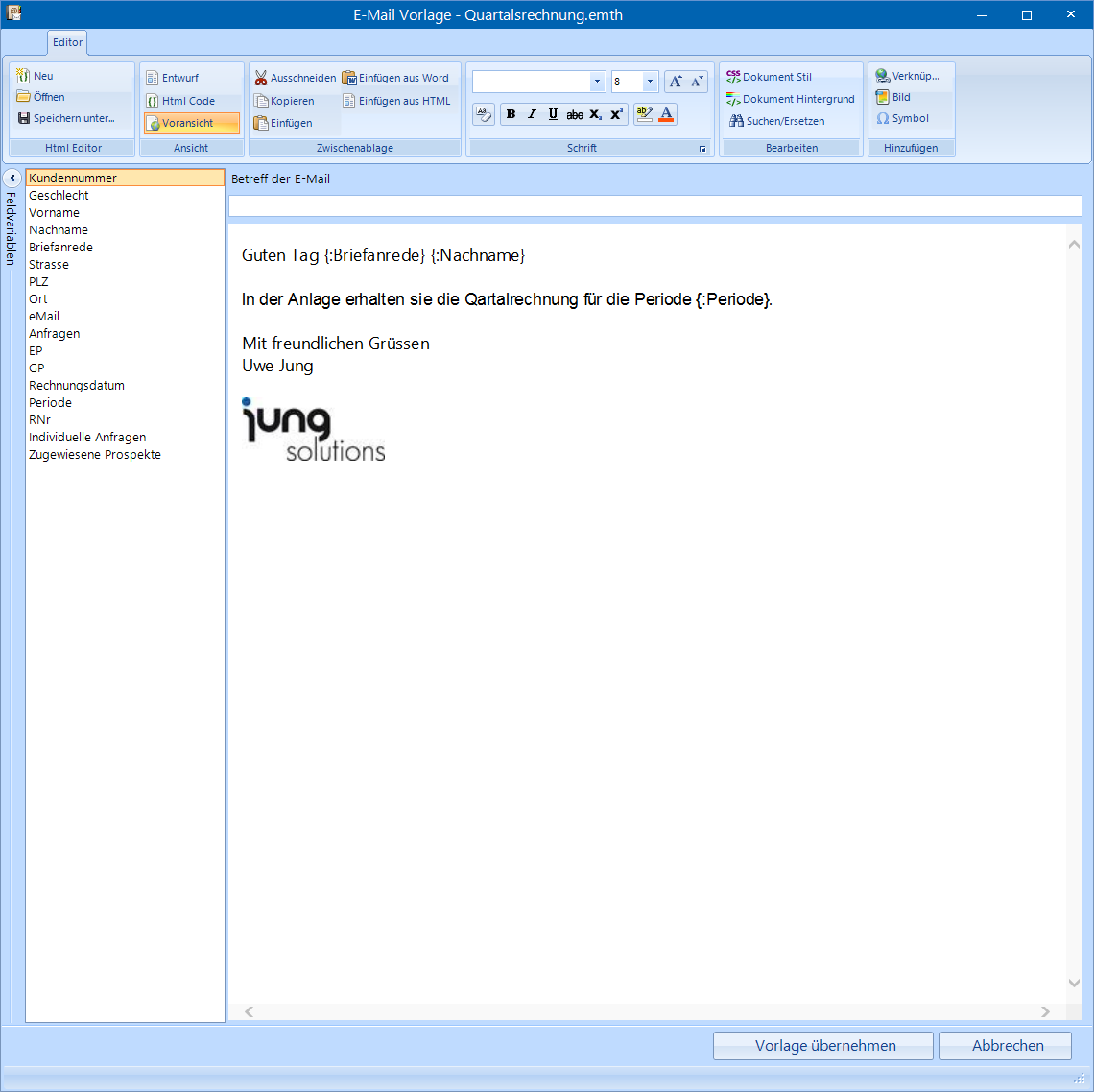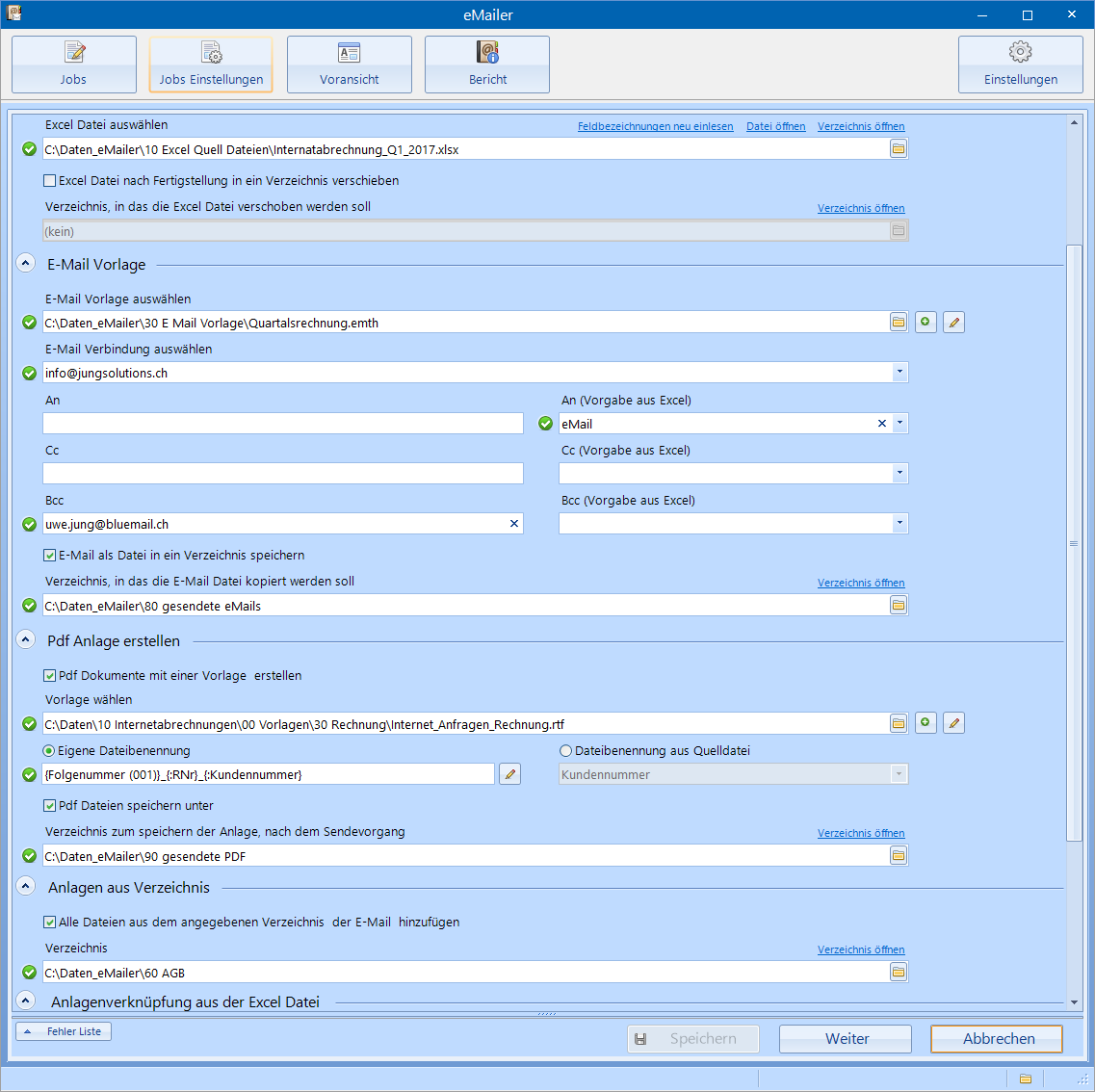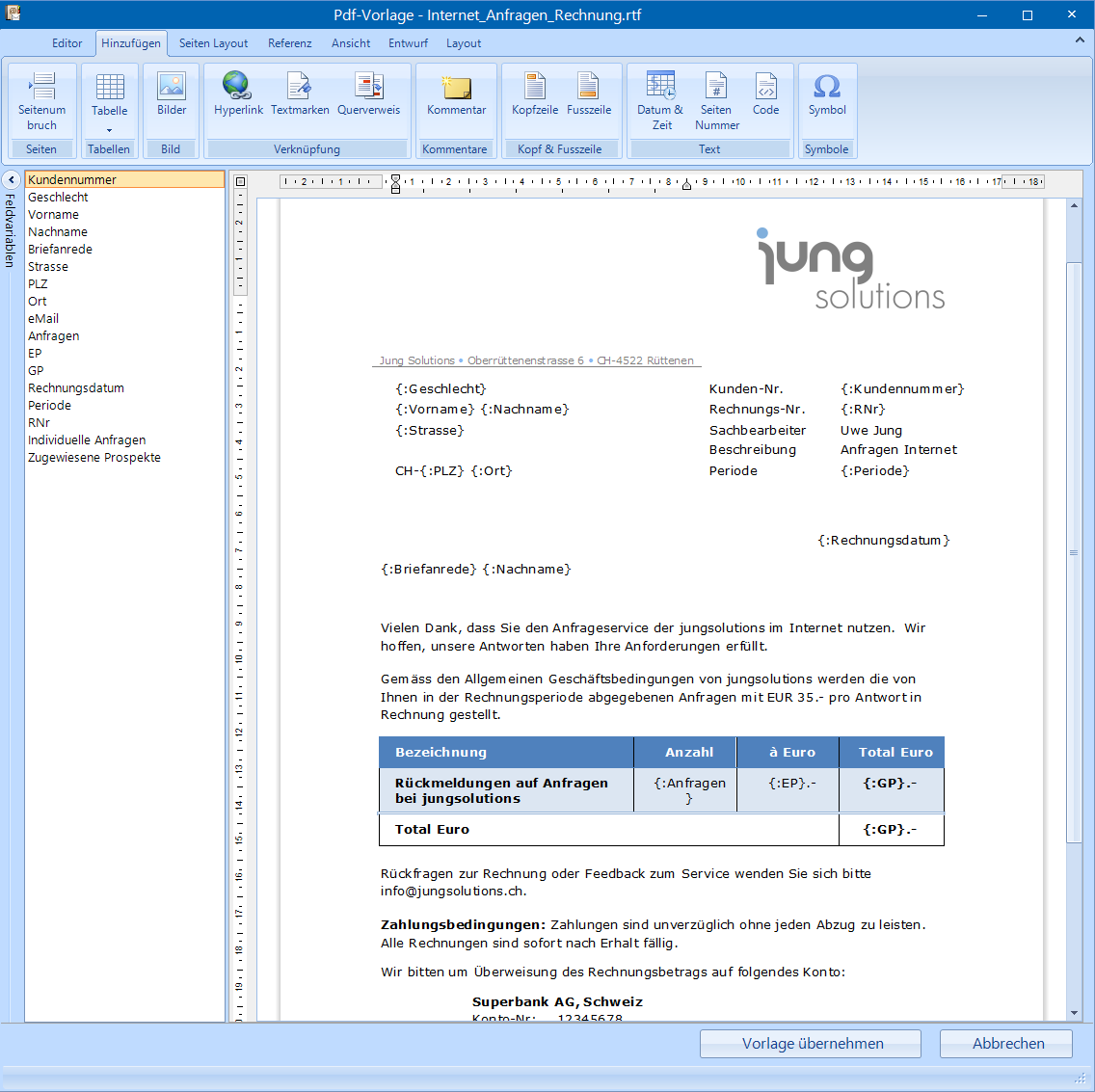The eMailer is used to send personalized e-mails using Excel-based data.
Not only is it possible to populate the email with data from a selected Excel file, but it is also possible to transfer this data by mail merge, converting it into a PDF file and attaching it to the email.
In addition, it is possible to optionally add various individual files to the e-mail as attachments.
The e-mail can be used to send invoices, course confirmations, invitations, test results, etc.
Trial version for download
You can download the eMailer as a trial version and test it at your leisure.
| Standard Windows version. To install it requires admin rights on PC. |
| Portable Windows version. It does not require admin rights on PC to install. |
License purchase
If you have become familiar with the eMailer and have seen how efficient your work becomes through using it, you can purchase the license here.
The eMailer from Jung-Solutions - very simple!
Compared with the standard Office version, the eMailer has the following advantages: In a single operation, the eMailer can link personalized e-mails with a serial letter created in PDF format and, if required, attach further individual files before automatic sending.
The eMailer can be used with emails set up in Outlook as well as with any webmails.
Cost savings in the office!
Those who regularly have to send large quantities of documents, e.g. invoices, audit results, invitations, etc., will save a lot of time and unnecessary costs, especially in the age of digitalisation, while at the same time protecting the environment, by sending e-mails.
Technical challenge!
Creating a form in Word, printing it out and sending the individual pages in an envelope is no problem for most users. However, when it comes to creating individual PDF files instead of printed pages, many users find it quite tricky. In addition to these editing steps, each individual PDF file has to be attached to the correct e-mail, which has to contain a personal text, and to which further attachments must also be added..
For individual control, each individual e-mail can be sent to its own e-mail address without having to change the data.
A successful conclusion!
After a successful check, e-mails are sent automatically and sequentially with a single mouse click. If desired, the e-mails to be sent can also be sent automatically in blocks (a previously individually defined number of e-mails) and at fixed intervals.
The sent e-mail is filed in the outbox folder of the e-mail client (e.g. Outlook). Optionally, the sent e-mail - like the PDF file created - can be saved in a file directory for documentation purposes.

The eMailer as a solution!
All these advantages can be implemented easily and with minimal effort with the eMailer. Once an e-mail has been sent, it can be re-sent at any time with updated data. All that is required in addition to the eMailer is a valid email address and an Excel file containing the necessary data for sending the email./p>
Permanent e-mail template!
It doesn't matter how often the same email has to be sent to different recipients - the required email template only has to be created once and no two emails will be the same. Each individual e-mail sent receives its own personal note with the individual data from the Excel file. A modern HTML editor is therefore available for creating the e-mail template.
Mail merge in PDF format!
The form letter template is created in the same way as the e-mail template. A powerful integrated text editor, very similar to MS-Word, is used for this. Templates from other text editors that have been saved as RTF files (RichTextFormat) can also be used. The template created in this way is added to the configuration of the desired e-mail. Before sending the e-mail, the form letter template is automatically populated with data from the Excel file, which is then converted into a PDF file and added to the e-mail as an attachment.
Positives for e-mail attachments!
Everything is possible! Either the attachments listed in the Excel file or any files from a specific directory can be added to any e-mail as attachments without any problems.
Performance characteristics
- Serialized emails can be sent easily.
- E-mail accounts used in Microsoft Outlook can be used without further configuration in the eMailer.
- Existing webmail accounts can be used after the configuration data is entered in the eMailer.
- The PDF files created at runtime from a mail merge are created separately and the individual PDF file is automatically named by entering a template.
- Any number of attachments can be added per defined directory and/or per file name.
- The file size of the attachments is displayed in the preview.
- The e-mail and the PDF generated can be previewed in the finished layout.
- The e-mail dispatch can be started in two ways. All mails are sent sequentially with a single send command. Alternatively, e-mails can be sent in small quantities at intervals with the aim of avoiding a mass mailing being identified as spam, thus ending up in the spam filter.
- After each dispatch, a record is created in an Excel file.
- The generated PDF files can be saved separately in a file directory.
- The e-mails sent can be saved as MSG (Outlook format) or EML (Webmail format) files in a file directory.
Trial version for download
You can download the eMailer as a trial version and test it at your leisure.
| Standard Windows version. To install it requires admin rights on PC. |
| Portable Windows version. It does not require admin rights on PC to install. |
License purchase
If you have become familiar with the eMailer and have seen how efficient your work becomes through using it, you can purchase the license here.
FAQ
Of course, the download version from the Internet is fully functional except for one restriction. The restriction is that you can only use the first five data sets from Excel. However, the purchase version is fully functional and can be used without any limitations.
A version of Microsoft Office is crucial for the successful use of the eMailer. the eMailer can be used without problems with Microsoft Office versions from 2013 (32 Bit / 64 Bit).
Unfortunately, Microsoft's File Explorer can only display an overview of e-mail files (*.msg) in the 32-bit version. Unfortunately, this is not yet possible with the 64 bit version.
Of course, newsletters created with other programs can be used. For this you use the HTML import function in the HTML editor. This allows you to define whether the images are stored on a web server, so that they can only be loaded into the e-mail on request, or whether the images should be embedded directly into the e-mail.
The eMailer can transfer already created newsletters in HTML format (also in Responsive Web Design) with the help of the import function and personalize them with the data from the Excel file used.
The eMailer is not so well suited to pure newsletter dispatch.
There are two good reasons for using this option.
- Especially in the creation phase of an e-mail job, it can be helpful if you do not send unwanted e-mails during the test phase. If the "Execute" button is clicked despite this, the process starts without sending the e-mails. The message "intentionally not sent" then appears in the journal.
- In addition, this setting can be used to create individual PDF files from a mail merge letter, each of which has its own file name. Microsoft Office does not offer this function; however, it is desired by many users.
Fundamentally, you can use the mail merge in the eMailer. However, two points must be considered.
- The Word file must be saved as an RTF file. (RTF is a general text editor format.) Some specific Word functions may be displayed differently or not. This must be checked on a case-by-case basis.
- Likewise, the dynamic data (tags) in the Word document must be replaced by the information in the eMailer so that the data from the Excel file can be displayed.
For non-profit associations we offer 15 % discount. To take advantage of this offer, please send us verification of your details (e.g. details of the association's homepage, entry in the official register). After successful verification, we will gladly send you a voucher code worth 15%, which you can redeem when shopping in our eShop.
We offer an attractive discount for orders of five or more eMailers. Please send a request before the purchase to info@jungsolutions.ch
This is only possible for commercial customers with a purchase quantity exceeding 100. Please send a request before the purchase to info@jungsolutions.ch
Unfortunately, there is no facility for prepayment with the eMailer. For payments, we offer the following options in our eShop: PayPal, Master Card, Visa Card and additionally Twint for Swiss customers.
The eMailer of course allows the sending of serial mails without attachments.
This functionality is the eMailer's enormous advantage. As long as the data used is stored in an Excel file, the defined job can be used again and again. The file name just has to be be adapted in the configuration. If the Excel file always has the same name and is in the original location, no changes are necessary in this case.
The eMailer checks every single field (tag) for its existence. If an entry is missing, this will be immediately displayed in the eMailer. The content or value of a field can of course not be checked.
This notification is made independently of the eMailer. The message is sent to the e-mail account that was used for sending the e-mail.






